Insider launches WhatsApp Flows to help brands deliver immersive shopping experiences
Insider is now accepting beta requests for brands who’d like to take advantage of our new WhatsApp Flows tool. This new feature allows brands to add app-like experiences within WhatsApp, which has the potential to boost conversions, increase average order values, and create an entirely new lead generation service for brands in a multitude of sectors.
Updated on 22 Jan 2024
What is WhatsApp Flows?
Meta has expanded its WhatsApp Business Platform by launching a new service: WhatsApp Flows. This feature enables brands to offer users the functionality of an immersive in-app shopping experience without them ever leaving the platform.
WhatsApp Flows allows brands to go from chatting with and advising users—which is already possible with WhatsApp business messaging—to completing transactions, such as choosing seats on flights or comparing car insurance premiums. It’s the full end-to-end branded customer journey within WhatsApp: the world’s most popular messaging platform.
Saying goodbye to redirect links
This is important because getting traffic to your website is not easy. Despite 77% of businesses using social media to reach customers in 2023, 61% of marketers say that generating traffic and leads is their number one challenge. Clearly, when it comes to the social media funnel, the biggest drop-off point is between the social media platform and a brand’s website or app.
Just picture it. You connect with a prospective customer on WhatsApp comparing winter boots. They’re looking for a pair as a present for their partner. Via the use of WhatsApp message templates, your marketing team has offered advice on available sizes, materials, and colors. The user is ready to buy…
But just as they click on the redirect link to a product page in your app, they’re called away to run an errand. When they return, they search for the boots on Google and find a pair with similar specs on a competitor’s website. They go ahead and make that purchase—and you lose a sale.
Most marketers have experienced something similar, regardless of the industry they’re in or the product they sell. That’s why WhatsApp has responded with WhatsApp Flows to enable eCommerce and non-eCommerce brands alike to create immersive, personalized app-like experiences with interactive flows, rich forms, and other structured ways to collect inputs from users.
Check out our exclusive Whatsapp product tours
Benefits of WhatsApp Flows
Those brands who learn to leverage WhatsApp Flows will experience a multitude of benefits. As we’ve seen, they can reduce the drop-off that comes with redirect links, as well as the cost and effort involved. But you can also say sayonara to the specter of broken links costing you conversions.
More than that, because you’re re-creating the rich, immersive experiences you offer within your branded app within the familiar WhatsApp interface, user adoption is simple and straightforward. Being able to offer the full range of immersive, intuitive, and actionable experiences builds trust. The lack of channel switching encourages faster outcomes and better response rates. It’s also safe and secure, with platform uptime in excess of what most brands can offer.
As most brands using WhatsApp for Business already know, WhatsApp is the third most popular social media platform and the number one messaging platform in the world. You’ll be leveraging that huge global reach and convenience.
Who should be using WhatsApp Flows?
Any company already using WhatsApp business messaging and the WhatsApp Business Platform should consider adopting WhatsApp Flows, especially since Meta is offering the new functionality at no extra cost. Think of it as taking WhatApp’s existing conversational messaging to the next level, with structured funnels and data capture.
At the same time, non-eCommerce verticals such as finance, automotive, media and others who weren’t able to fully adopt WhatsApp in the past can now take full advantage of this channel. Any brand can now leverage WhatsApp Flows for interacting and collecting customer input, bringing branded app-like experiences into messaging.
And not only is this channel ideal for collecting contact details, generating leads, and building customer relationships. Because WhatsApp payments are available in most markets, you can provide full end-to-end experiences to your customers, from browsing to lead generation all the way to making purchases. Let’s explore a few examples.
Booking a flight seat
A business traveler has booked a flight to a city she doesn’t know and where she must attend several business meetings next week. She has a lot on her mind and doesn’t want to take up too much time thinking about such a small task when she has several presentations to complete.
By sending the traveler through to WhatsApp after purchasing her ticket, the brand can prompt her to choose a seat. Initially, the brand’s WhatsApp chat bot might ask if the traveler prefers something comfortable, something convenient that’s close to an exit, or any other preference. They can then send her to a form pre-populated with the date, time, and location of the trip. On clicking confirm, she is then offered a choice of seat.
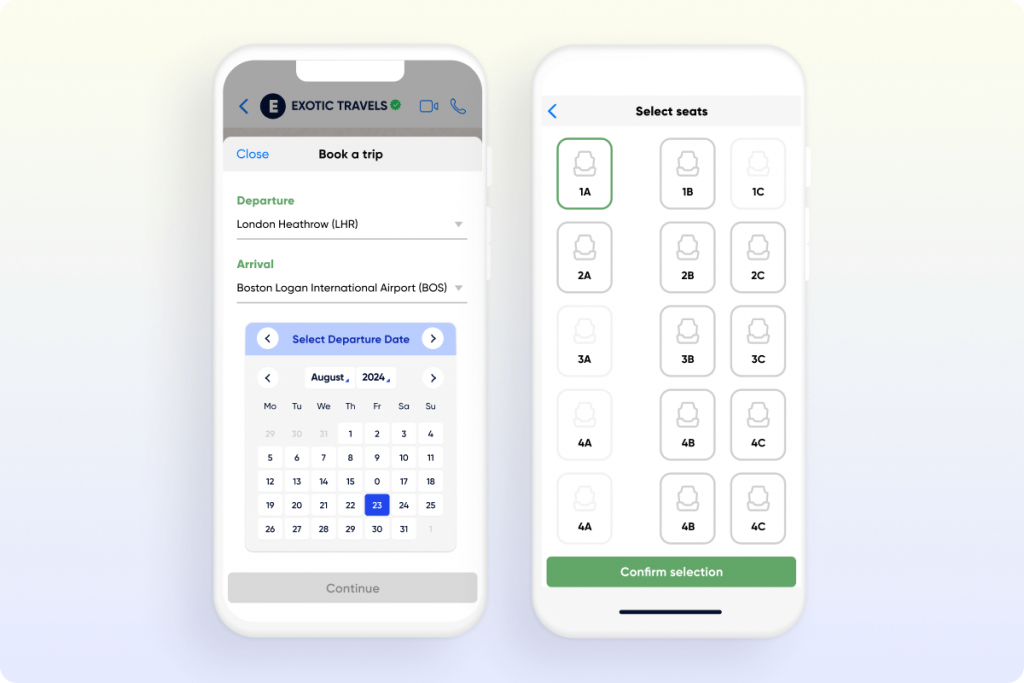
Booking a restaurant
That same business traveler now searches for a vegetarian restaurant. She finds an ad about the best vegetarian restaurants in the city which links to a sponsored blog. The blog contains a link to a restaurant on WhatsApp where she can ask about gluten-free options. The initial conversation confirms that they have several gluten-free options and asks if she would like to book a table.
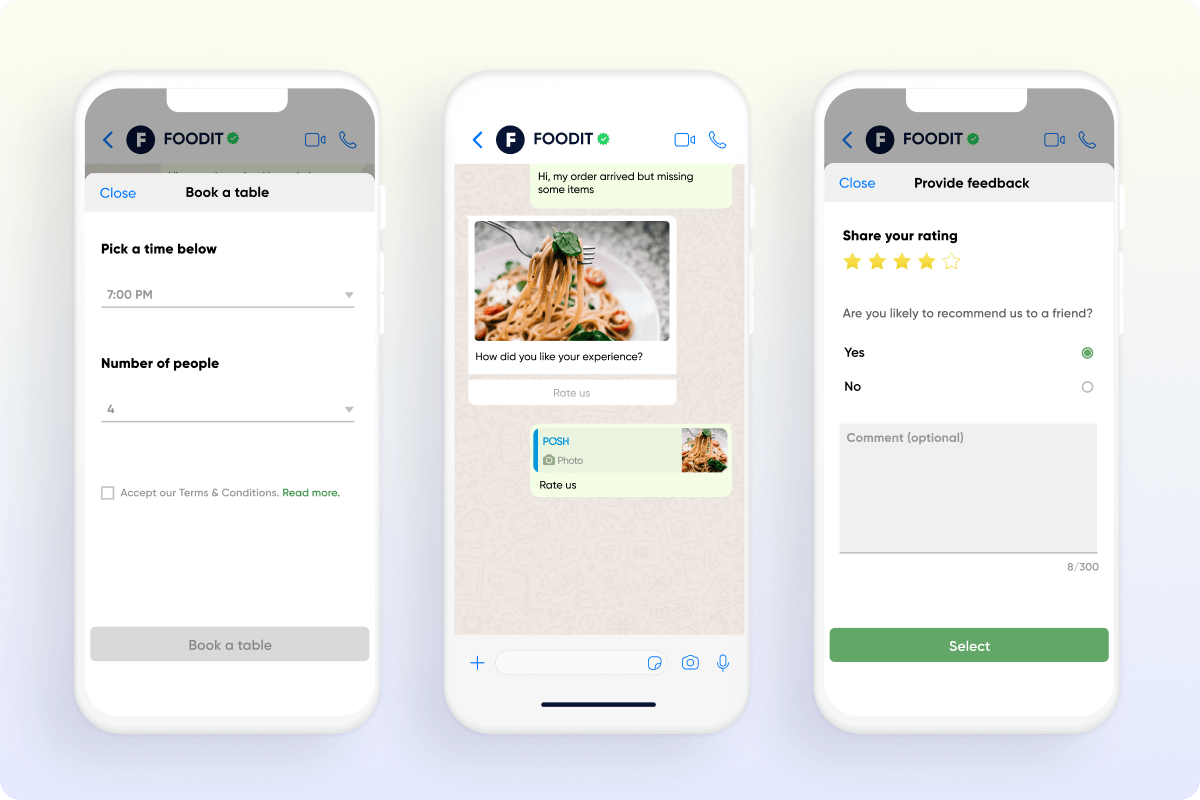
With live updates on available time slots, the traveler can check availability and book a table for 8pm on the evening she flies in. The entire journey from inquiry to booking has been smooth and easy. She can now relax, having ticked off one of the tasks on her to-do list.
Collecting preference data
A customer browses the website of a media brand, where they’re invited to opt-in to WhatsApp messaging through welcome pop-ups, thank you pages, and other entry points. Once in WhatsApp, they see a pop-up asking what they’re looking for.
The media brand can then use Flows to collect preference data using a variety of familiar input fields including radio buttons, multiple choice, drop downs, and more. When done pre-purchase, this can be tied to lead generation campaigns, boosting average order value and revenue.
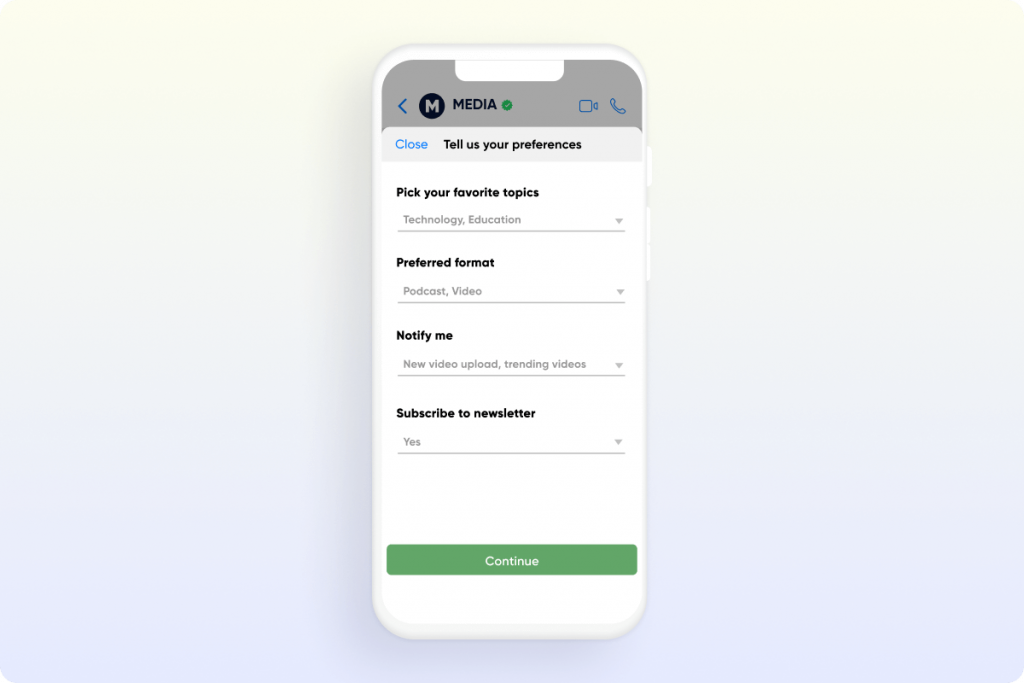
Brands can also offer the same functionality post-purchase, following up with a survey that collects preference data they can use to make personalized offers, thereby increasing the likelihood of repeat purchases.
Trying a new product
Now imagine that same customer is browsing for skincare products. She sees an ad that contains a QR code or link to that same beauty brand’s WhatsApp, offering a 10% discount.
On landing in WhatsApp, the customer is asked to join the brand’s rewards scheme to claim her discount. A pop-up asks for her name, email, and phone number. She is then asked to state her communication preference so she can be sent her discount code via email or SMS.
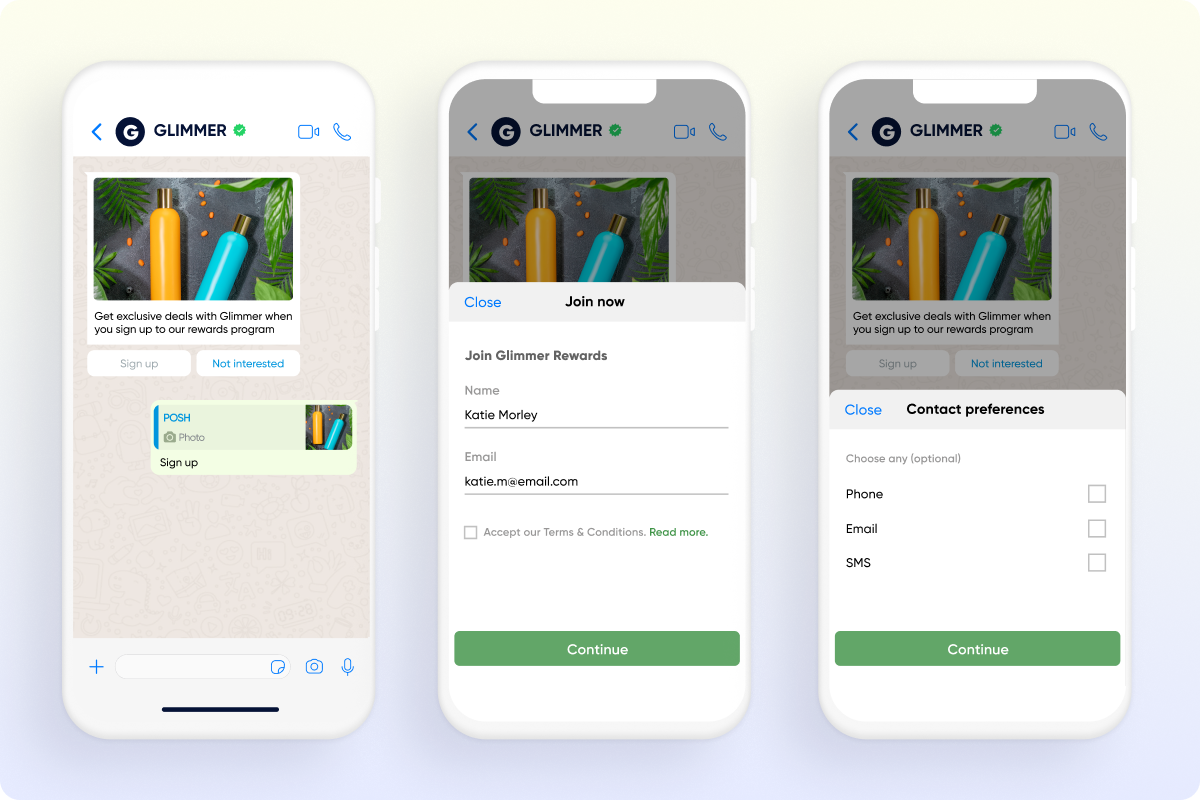
In this way, the customer gets to enjoy a discount on her purchase with a new brand. The brand gets to generate a new warm, engaged lead who is highly likely to make a purchase.
Signing up for a test drive or book a service
For most people, a new car is the second biggest purchase they make in their life, after buying a house. They need advice and often don’t want to visit a showroom for fear of being pressured into a sale.
With WhatsApp Flows, a car brand can engage prospects in conversation. They can also create an AI-powered virtual assistant to answer the most common questions, after which, WhatsApp Flows will direct the prospect to a sign-up page where they can book a test drive to see the car in person.
And they don’t even have to visit the showroom. By offering fields including date, time, and pick-up location, the brand can drive the car to the prospect for them to start their test drive from their house. It’s the ultimate in omnichannel customer service!
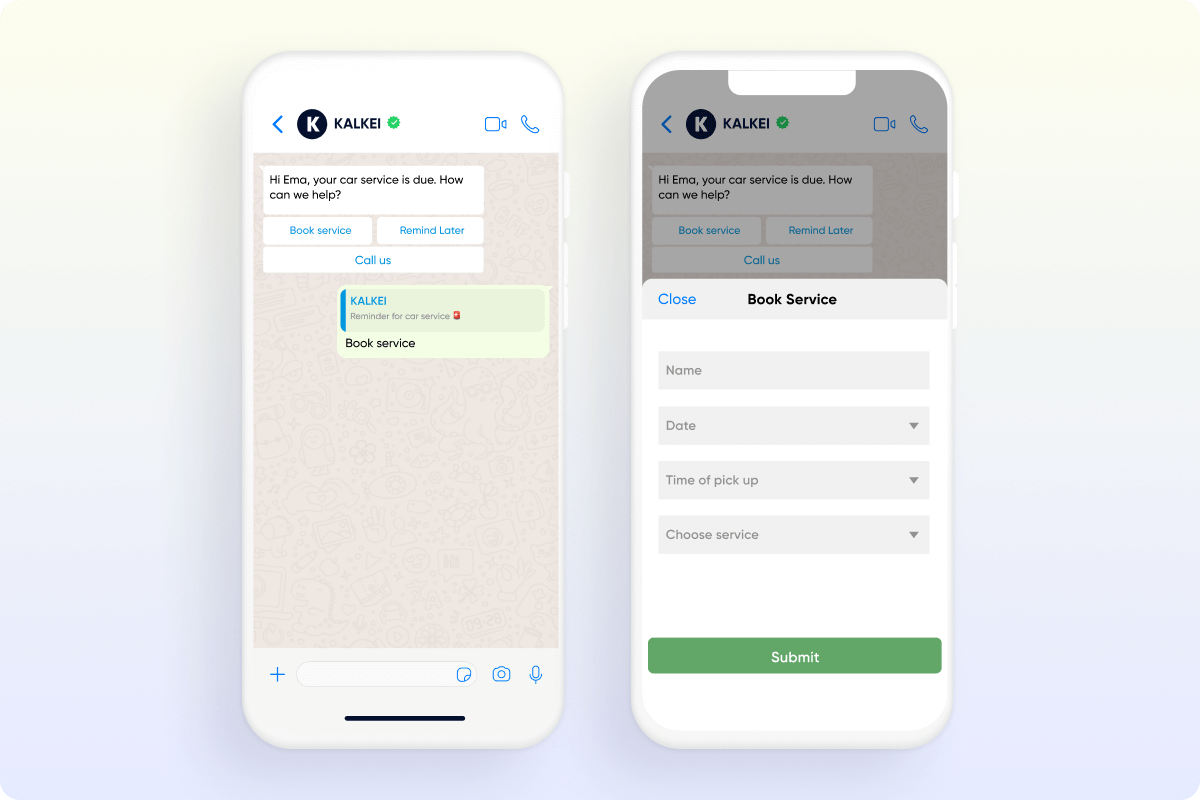
Choosing home insurance
Insurance companies can provide QR codes on their website or add WhatsApp links to their ads to allow customers to reach out to them directly on WhatsApp. They can then include an interactive purchase assistance flow to help them choose the right policy based on the data they enter in-app without needing to be redirected.
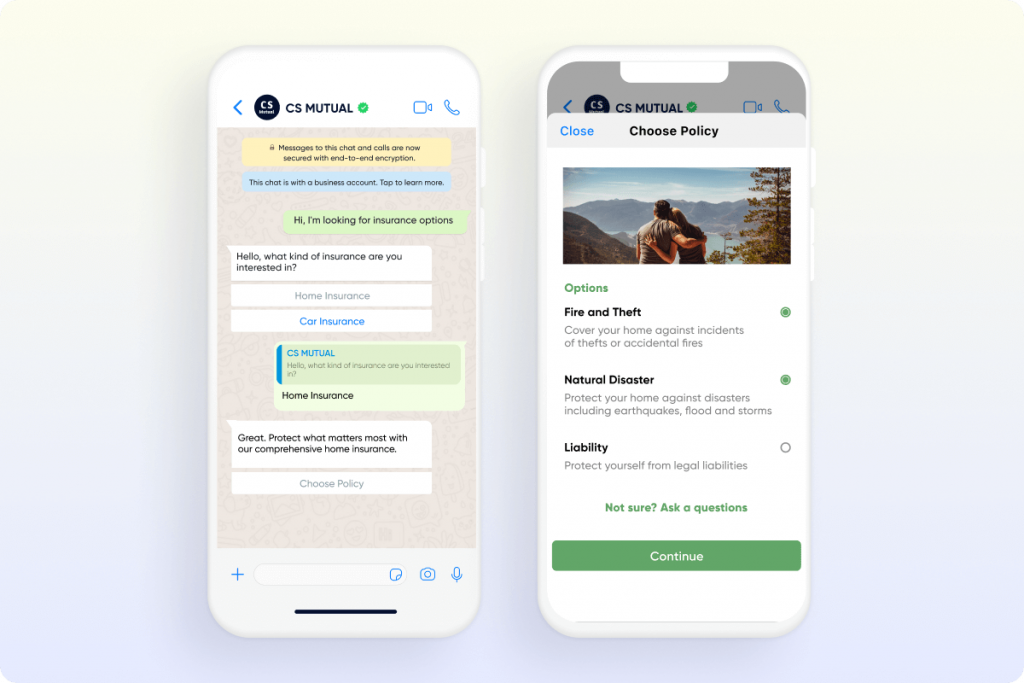
This concept works brilliantly for insurance firms who want to compete on service in a world where pricing strategies are increasingly heavily regulated, and competition is fierce. It reduces drop-off by making the process of essential data gathering smoother and more convenient, which is often the key to converting an inquiry into a customer.
How WhatsApp Flows protects even the most sensitive customer data
Some in the financial and medical fields may be worried about using a third-party service for collecting personal data. However, WhatsApp takes pains to protect all customer data.
For starters, the data is used mainly for marketing, lead generation, etc. It cannot be used to conduct financial transactions; this function is only available through WhatsApp Payments. This means brands are unable to access customers’ account information on the platform. At the same time, Meta doesn’t own this data but routes it directly to the brand customers are interacting with.
Businesses are able to use this contact data to advertise themselves on Meta, but Meta will not use this data for its own marketing purposes. Nor can it sell or rent that customer data to anyone else.
WhatsApp messages are protected by the same encryption protocol that secures messages before they leave a customer’s device. When messaging a WhatsApp business account, the customers’ message is delivered securely to the destination chosen by the business.
All chats with businesses that use the WhatsApp Business app or manage and store customer messages themselves are end-to-end encrypted. Once the message is received, businesses can apply their own privacy policies. Meta will not store any of this information unless expressly asked to do so.
How to leverage WhatsApp Flows in your organization
As we all know, when it comes to digital communication, convenience is paramount to engaging users. Now you’ve had a taste of how WhatsApp Flows can replace clunky back-and-forth processes with smoother, more seamless customer journeys, you’re likely keen to start trying it out in your business.
Drop us a line to find out more about using this new feature.
Get early accessFrequently Asked Questions
Below are some of the most common questions our clients ask about WhatsApp Flows. If you have a question, see if the answer is here. If not, get in touch:
WhatsApp Flows is the latest service on the WhatsApp business platform. It enables e-commerce and non-e-commerce brands alike to create immersive app-like experiences with interactive flows, rich forms, and other structured ways to collect inputs from users.
It’s ideal for collecting contact information, generating leads, building relationships, and providing extra customer services to increase average order value, boost customer lifetime value, and drive revenues.
Using WhatsApp Flows reduces user drop-off because you no longer need to redirect them to your website or app to collect marketing and contact data. It increases response rates and cuts the time to conversion.
Meta is not charging any extra for this feature. So all you need is to set up a WhatsApp for Business account to get started. This involves setting up the WhatsApp Cloud API and adding your business details. Then you’re ready to start creating your first flow.
In the WhatsApp Manager of your WhatsApp Business Account, select Account Tools on the left-side menu and then click Flows.
From here you’ll find the button called Create Flow at the top right of the page. When you click that, it opens a dialog where you can enter some details about your Flow, including giving it a name and filling in a relevant category and template.
Then you must build your Flow and test it. After that, you’re ready for launch!
Every business has its own challenges and priorities and yours is no different. The best next step is to get in touch with us for a no-obligation chat to find out more about what’s possible and what’s likely to work best in your context.



















